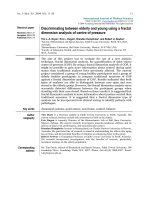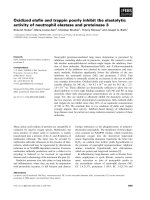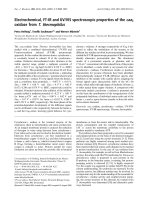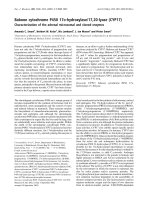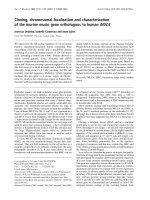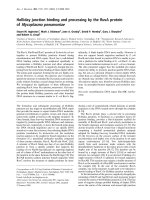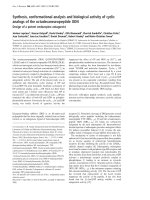Báo cáo y học: "Equipoise, design bias, and randomized controlled trials: the elusive ethics of new drug development" docx
Bạn đang xem bản rút gọn của tài liệu. Xem và tải ngay bản đầy đủ của tài liệu tại đây (70.41 KB, 6 trang )
R250
Introduction
The concept of ‘equipoise’, the ‘uncertainty principle’, has
been represented as a central ethical principle of human
experimentation [1–15]. Equipoise holds that a patient
may be enrolled ethically into a randomized controlled trial
(RCT) only when substantial uncertainty surrounds which
of the trial treatments would most likely benefit them. More
formally, “to be in equipoise between two treatments A
and B is to be cognitively indifferent between the statement
‘A is strictly more effective than B’ and its negation …
equipoise regarding A and B is necessary for randomized
assignment to treatments A and B to be beneficent and
non-maleficent and is sufficient for such an assignment to
be fair” [1]. In the strictest mathematical formulations,
equipoise has been held to require that the prior
probability for either treatment A or treatment B being
superior to the other is 0.5.
Such definitions of equipoise, if literally interpreted, would
substantially impede RCT-based clinical research. Indeed,
when is nothing known before a trial that would permit
inference of the ‘better’ arm with an accuracy exceeding
50%? Few, if any, RCTs would be ‘ethical’ according to
such rigid definitions. Such concerns have led to a
softening of definitions. Equipoise, it has been suggested,
could represent uncertainty in the collective conventional
scientific wisdom, in the patient community, or in the mind
of the potential participant or of an individual physician
ACR = American College of Rheumatology; FDA = Food and Drug Administration; RCT = randomized controlled trial.
Arthritis Research & Therapy Vol 6 No 3 Fries and Krishnan
Research article
Equipoise, design bias, and randomized controlled trials: the
elusive ethics of new drug development
James F Fries and Eswar Krishnan
Stanford University School of Medicine, Palo Alto, California, USA
Corresponding author: James F Fries (e-mail: )
Received: 4 Feb 2004 Revisions requested: 24 Feb 2004 Revisions received: 24 Feb 2004 Accepted: 3 Mar 2004 Published: 18 Mar 2004
Arthritis Res Ther 2004, 6:R250-R255 (DOI 10.1186/ar1170)
© 2004 Fries and Krishnan, licensee BioMed Central Ltd. This is an Open Access article: verbatim copying and redistribution of this article are
permitted in all media for any purpose, provided this notice is preserved along with the article's original URL.
Abstract
The concept of ‘equipoise’, or the ‘uncertainty principle’, has
been represented as a central ethical principle, and holds that a
subject may be enrolled in a randomized controlled trial (RCT)
only if there is true uncertainty about which of the trial arms is
most likely to benefit the patient. We sought to estimate the
frequency with which equipoise conditions were met in industry-
sponsored RCTs in rheumatology, to explore the reasons for
any deviations from equipoise, to examine the concept of
‘design bias’, and to consider alternative ethical formulations
that might improve subject safety and autonomy. We studied
abstracts accepted for the 2001 American College of
Rheumatology meetings that reported RCTs, acknowledged
industry sponsorship, and had clinical end-points (n = 45), and
examined the proportion of studies that favored the registration
or marketing of the sponsor’s drug. In every trial (45/45) results
were favorable to the sponsor, indicating that results could have
been predicted in advance solely by knowledge of sponsorship
(P < 0.0001). Equipoise clearly was being systematically
violated. Publication bias appeared to be an incomplete
explanation for this dramatic result; this bias occurs after a study
is completed. Rather, we hypothesize that ‘design bias’, in
which extensive preliminary data are used to design studies with
a high likelihood of being positive, is the major cause of the
asymmetric results. Design ‘bias’ occurs before the trial is
begun and is inconsistent with the equipoise principle.
However, design bias increases scientific efficiency, decreases
drug development costs, and limits the number of subjects
required, probably reducing aggregate risks to participants.
Conceptual and ethical issues were found with the equipoise
principle, which encourages performance of negative studies;
ignores patient values, patient autonomy, and social benefits; is
applied at a conceptually inappropriate decision point (after
randomization rather than before); and is in conflict with the
Belmont, Nuremberg, and other sets of ethical principles, as
well as with US Food and Drug Administration procedures. We
propose a principle of ‘positive expected outcomes’, which
informs the assessment that a trial is ethical, together with a
restatement of the priority of personal autonomy.
Keywords: design bias, ethical principles, equipoise, expected outcomes, randomized controlled trials
Open Access
Available online />R251
[2,3]. ‘Zones of indifference’ could be constructed around
the equipoise (50:50) point. In one study of patient
opinions, one half believed a trial to be unethical if
equipoise was disturbed beyond 70:30, and 97%
believed it unethical if equipoise were disturbed beyond
80:20 [4]. It was recently argued that perceptions of
basic fairness (not necessarily equipoise) are important to
the decision to accept a trial [5]. Much of the medical
ethics based equipoise literature has attempted to
harmonize the uncertainty principle with the need for
medical progress. The ethical basis of equipoise itself has
seldom been challenged.
The term ‘equipoise’, in the context of RCTs, means the
following [6]: participants will not suffer relative harm from
random assignment to a particular treatment arm; the results
of a study cannot be predicted consistently in advance; and
over a number of RCTs those proving or failing to prove an
hypothesis will be approximately equal in number.
Methods
Industry-sponsored RCT abstracts accepted for the 2001
American College of Rheumatology (ACR) meetings [16]
were studied. All abstracts (n = 45) reporting RCTs,
acknowledging pharmaceutical company sponsorships as
required by the ACR, containing a study arm with a drug
from that sponsor, and having clinical end-points were
analyzed. Abstracts were categorized as ‘favorable’ or
‘unfavorable’ to the sponsor’s drug. ‘Favorable’ required
superiority in efficacy to placebo or comparator.
Note that the analysis comprised abstracts numbered
88, 89, 90, 149, 151, 152, 179, 190, 221, 224, 226,
429, 432, 492, 494, 495, 496, 497, 498, 500, 502,
595, 599, 603, 604, 631, 727, 802, 809, 810, 965,
968, 976, 1032, 1327, 1550, 1595, 1808, 1809, 1896,
1897, 1904, 1915, 1917, and 1921 from the ACR
report [16].
Results
The results from every RCT (45 out of 45) favored the
drug of the sponsor (P < 0.0001).
Discussion
Clearly, the results of these trials could have been
accurately predicted based on knowledge of sponsorship
alone. The studies appeared to be well executed in
general, most had academic authorship, and they were
intended to survive stringent US Food and Drug
Administration (FDA) review. Hence, we considered that
poor scientific quality was unlikely to be a major
contributor to this result. It actually has been suggested
that ‘quality scores’ of industry-sponsored RCTs may be
better than those of publicly funded RCTs [6],
strengthening our belief that these studies were generally
carefully and accurately performed.
How, then, could these results have been so predictable?
There are at least four nonexclusive potential explanations.
First, a placebo control was employed as an arm in 32 of
the 45 studies, and prestudy evidence (e.g. phase I, II, and
prior phase III studies) is likely to have suggested that the
new drug would be found to be superior to placebo.
Second, of the 22 studies in which an active comparator
arm was used, three were derived from previously
reported RCTs, essentially reporting the same trial using
different end-points such as cost or quality of life. Third,
‘publication bias’, discussed below, might have played a
role. Finally, we suggest that a relatively undiscussed bias,
‘design bias’, is likely to have contributed substantially to
the predictability of these results.
In the present study we only studied abstracts for one
meeting in one medical specialty, and we classified studies
using only information available in the abstract. This might
limit the ability to generalize from our findings, and
certainly if one looked at enough trials some exceptions
would be found. However, our results are confirmed by
many other studies. In a study of 61 industry-sponsored
trials of nonsteroidal anti-inflammatory drugs [17], 100%
of trials found the sponsor’s drugs comparable or superior
to the comparator; no studies favored the comparison
treatment. In multiple myeloma trials, equipoise was
generally met in publicly funded RCTs, but 74% of
commercial RCTs favored the new product, suggesting
differences related to funding source [6]. Bekelman and
coworkers [18] found financial conflicts of interest to be
widespread. Als-Nielsen and colleagues [19] found that
funding source was related to reported conclusions in
drug trials. On the other hand, many publicly sponsored
RCTs address issues with uncertain outcomes (see
O’Dell and coworkers [20]). However, a large majority of
industry-sponsored trials must violate the principle of
equipoise.
Publication bias
Publication bias, where positive studies are more likely to
be published than negative ones, is an obvious potential
explanation for these findings. However, the magnitude of
publication bias remains controversial, and a number of
studies suggest that this type of bias has only small
effects [21–24], whereas our observed effects are huge.
Recently, publication bias in oncology trials was noted to
include more specific causes of ‘lack of time or resources’,
‘incomplete study’, and others that are not necessarily
related to study outcome. Only 10% of unpublished
papers were so categorized because of insufficient priority
to warrant publication; 81% of positive trials and 70% of
negative ones were published, suggesting a publication
bias of perhaps 13% [25]. Publication bias is thus unlikely
to account for the unanimity of the results reported here,
although it is likely to have played some role. Publication
bias occurs after an RCT has been completed.
Arthritis Research & Therapy Vol 6 No 3 Fries and Krishnan
R252
Design bias
Design bias, on the other hand, occurs before the RCT is
begun, when the trial parameters are determined and
before the final decision has been made to initiate the
study [21]. Major deviations from equipoise appear to
result from the design stage, particularly during the drug
development process.
Consider the drug development sequence from the
perspective of the sponsor. A promising agent is found.
Then, there are pharmacological studies, pharmacokinetic
studies, animal studies, initial studies in humans, dose
ranging studies, toxicity studies, and others (Fig. 1). Most
potential medications fail to pass these hurdles. Only
drugs that continue to show promise are considered for
expensive RCTs, and there is already a great deal known
about these drugs.
From an industry perspective the drug development
process must involve ‘designing for success’ (Fig. 1). In a
well established set of procedures company consultants
and staff debate what is known about the drug, its
competitors, its potential advantages in terms of toxicity or
efficacy, and the potential disease indications. One of us
(JFF) has frequently been involved in this process. Then,
trials are designed that include the patients, dosages,
study duration, end-points, and comparators that are likely
to provide a positive result for the sponsor and one that is
acceptable to the US FDA. These design decisions are
intended in part to identify the most appropriate clinical
niche for the product, using all prior information. A funding
commitment by a for-profit entity to an RCT that may cost
hundreds of millions of dollars simply will not be made
unless a positive outcome may be predicted with
considerable certainty.
Is ‘design bias’ a bad thing? At first it appears so. After
reflection, however, we would suggest ‘not necessarily’.
How else should studies be designed? Should we study
drugs without promise – study drugs that are not thought
to be superior to placebo or drugs with no known potential
advantages over existing drugs? Should we conduct
studies that fail to identify an appropriate, perhaps narrow,
therapeutic niche for the drug? From a trial participant’s
perspective, the current design process limits the chance
of exposure to an ineffective or unduly toxic drug. From a
social perspective, violation of equipoise is essential to
efficient medical progress. To enroll humans in large RCTs
without preliminary studies might pose truly major risks to
participants, but after preliminary studies have been
conducted true uncertainty no longer exists. The principle
of equipoise becomes the paradox of equipoise.
Figure 1
The drug development sequence. Note that the drug sponsor accumulates large amounts of data about the drug, and has eliminated the least
promising agents before the design process for randomized controlled trials occurs.
Drug Development Sequence Including the Trial Design Step
Pre-Clinical Studies
Stop
Safety/Dosing
Studies
Stop
Uncontrolled Efficacy/ Safety
Studies
Stop
Design potentially positive Randomized
Controlled Trials (RCTs
)
Stop
Implement Clinical Trial
Program
PHASE 1
PHASE 2
PHASE 3
No good designs
Low potential
Promising designs
Good potential
Ethical issues with equipoise
The equipoise principle, upon examination, actually contri-
butes to ethical problems, in part because it embodies an
unreasonably paternalistic attitude. When we, as
clinicians, ask a patient to consider participation in a trial,
the typical responses are ‘Might this study help others?’ and
‘Are the risks reasonable?’ In stark contrast, the equipoise
principle does not allow consideration of potential social
benefits or consideration of the magnitude of the (often
very small) risk to the patient. Contrary to the altruism
expressed by many patients, equipoise gives weight
neither to personal autonomy nor to personal satisfaction.
Of substantial importance, the authoritative Belmont Report
[26], the US National Institutes of Health, the US FDA,
and the Nuremberg Code [27] do not require equipoise.
The Belmont Report enunciates three principles:
autonomy (respect for persons), beneficence, and justice.
Autonomy refers to the patient who, unless of diminished
mental capacity or under coercion, is capable of self-
determination and must be granted its exercise. Beneficence
refers to study designs that to the greatest degree possible
maximize benefits and minimize risks to the patient. Justice
refers to fairness in distributing the benefits and burdens
of research. The concluding section of the Belmont
Report notes a standard of ‘the reasonable volunteer’ and
that ‘no undisclosed risks may be more than minimal’.
Even more importantly, ‘risks to subjects must be out-
weighed by the sum of the anticipated benefit to the subject,
if any, and the anticipated benefit to society’ and ‘beneficence
requires that we protect against risk of harm to subjects and
also that we be concerned about the loss of substantial
benefits that might be gained from research’ [26].
Equipoise fails as an ethical principle because it directly
contradicts the principle of personal autonomy and fails to
consider the balance between the individual and the
societal good. It implicitly encourages performance of
trials that will prove uninformative by limiting the expected
differences between the arms of the trial. It has been
suggested, with similar reasoning, that underpowered
RCTs are unethical because the resulting negative results
may not benefit society [28,29].
We propose two principles that more appropriately
underlie the ethics of enrollment of experimental subjects
into an RCT: positive expected value and exercise of
personal autonomy.
First principle: positive expected value of participation
The equipoise principle is applied at an inappropriate
point in time. The subject’s decision is whether to accept
or decline a trial, not which arm to enroll in (Fig. 2). The
decision to accept the trial necessarily comes before the
randomization procedure, which assigns the patient to a
particular study arm. The patient, without foreknowledge
of the arm to be assigned, must base the decision to
accept the trial upon the pooled expectation for the RCT
arms and not upon the value of any single arm. The
principle of ‘equal uncertainty between the arms of the
RCT’ must be replaced with the principle of a reasonable
‘expected value’ for the participant after pooling the RCT
arms. The standard becomes the expected value of
outcomes after declining the RCT (usual care) as
compared with the average expected value of outcomes
after accepting the trial. This comparison does not depend
on the expected values of the individual arms of the RCT
but on their pooled average.
For example, consider an RCT of a new drug that is
believed likely to reduce osteoarthritis pain by 40% versus
a clinical standard known to reduce pain by 20%. Before
randomization, each participant has a pooled expected
value of a pain reduction of 30%, which is 10% more pain
relief than under usual care. The expected value of
participation is positive – it is of greater value to the
participant than declining the RCT and accepting usual
care, and the study is ethically sound – but it does not
meet the weaker principle of ‘equipoise’ or ‘uncertainty’.
Placebo-controlled RCTs will usually have positive pooled
expected values when new drug and placebo alike are
added to usual care. However, if the placebo and the new
drug replace usual care a study may not have positive
pooled expected values. If usual care is expected to yield
30% pain reduction, placebo 10%, and new drug 40%, then
the pooled average of the arms of 25% is less beneficial
than usual care. For the ‘positive expected value’ principal to
be met in this instance, the expected pooled positive effects
from the placebo and new drug must exceed the expected
negative effect from the loss of usual care.
The equipoise principle is replaced here by a new ethical
standard of reasonable ‘positive expected value’ with a
higher standard in protection of the participant. Unlike
equipoise, this standard allows placebo-controlled RCTs
with predictable results, where the net effect over all
participants is expected to be a benefit. It does away with
the charade of pretending not to know the likely outcome
in advance.
Second principle: autonomy for patients to make decisions
despite negative average expected value
The reasonable and autonomous prospective participant
might wish to accept an RCT even though the pooled
expected value is negative. Therefore, following full factual
review of expected outcomes with the potential
participant, the personal values of that patient need to be
applied. A common circumstance is altruism, with the
patient valuing social progress higher than personal risks.
In other instances, minimal increases in risks, although
real, may be of little importance to the patient.
Available online />R253
Another circumstance is the choice of a decision strategy
other than ‘expected value’ by the patient. ‘Expected value’
is not the only defensible decision strategy for an individual;
decisions may be driven by a desire to have a chance at
the best possible outcome or to avoid the possibility of the
worst possible outcome. A reasonable person could
choose to participate in an RCT because the best possible
result could only come from acceptance, even if the
pooled expected value of accepting the RCT is negative.
For example, accepting an RCT might be the only possible
way to gain access to a new treatment. Alternatively,
another reasonable potential participant could decline a
trial with a positive average expected value because of
excessive fear about the described potential side effects
of the new drug (‘risk aversion’).
Autonomy implies the ability to make decisions under a
personal rather than an externally imposed value system.
However, the standard is that of the ‘reasonable person’.
Autonomy also implies absence of coercion, full disclosure
of significant risks, and protection of those with limited
mental capacity, as well as other experimental subject
protections described in the Belmont Report [26].
We do not propose that formal decision analysis (expert
driven) and utility assignment (patient driven) should be
required of prospective participants, although they could
well be helpful to institutional review boards. The complexity
of the discussion must be appropriate for the patient.
However, formalizing the concepts helps to clarify the
issues involved. In a similar vein, Lilford [30] recently noted
that ‘choices should be based both on probabilities of
events (which experts might know) and on the value that a
patient places on these events (which only the patient can
know)’.
In a broader sense, we note that this same decision process
should apply to all studies involving human participant,
and not only RCTs. A forthright invitation, objective
explanation of known facts, application of the patient’s
personal values, and a reasonable and autonomous
decision are salient necessities for all such studies.
Equipoise is a false and diverting principle, and should be
replaced by ‘positive expected value’ using the patient’s
values, with elimination of the internal contradictions that
surround the concept of equipoise and with a return to
the Belmont principles. In this context, should we worry
that a large majority of commercial clinical trials are
positive? The answer is this is ‘yes and no’. Certainly,
skepticism and vigilance are required with industry-
sponsored trials because there are inevitably large financial
interests, and omitted results, redundant presentations,
and marketing ‘spin’ do sometimes occur [18,19,29,31].
Studies designed to evaluate noninferiority with an US
FDA approved comparator may represent ‘me too’ drugs
Arthritis Research & Therapy Vol 6 No 3 Fries and Krishnan
R254
Figure 2
Presentation of a randomized trial protocol for consideration by a patient. This presents an idealized sequence of invitation, factual evaluation,
ethical valuation, decision, and randomization. Note that factual evaluation contrasts benefits and risks of usual care versus the expected benefits
and risks of the trial after pooling all arms, and that the decision point always comes before randomization and hence is independent of the relative
expectations for the different arms of the trial.
The Utility of Expected Values in a Randomized Clinical Trial
Competent, non-
coerced patients
meeting entry
criteria asked to
consider trial
Pooled
expected
outcomes of
all trial
arms
Expected
outcomes of
usual care
VERSUS
Personal societal
interest and
self-
interest
Decision
Node
Personal, societal
interest and
self-
interest
Accept
trial Randomization
Invitation Evaluation Valuation Decision Randomization
VERSUS
Decline trial
and raise questions about a societal need for a drug. On
the other hand, the ability to design clinical trials for
success, and therefore to be able to predict outcomes in
advance, implies the ability to cull weak drugs early in the
approval process (and this frequently occurs), thus
exposing fewer patients, improving efficiency in drug
development, possibly reducing the cost of pharma-
ceuticals [32], and identifying those drugs that are most
likely to be clinically useful and of positive social value.
Conclusion
The pseudo-ethical principle of equipoise, with its
inappropriate decision point, must be abandoned. It
disregards patient autonomy, fails to protect patients on
aggregate, ignores potential benefits to society and
impedes medical progress, and there are better alternatives.
Competing interests
None declared.
Acknowledgement
This work was supported by a grant from the US National Institutes of
Health (AR43584) to ARAMIS (Arthritis, Rheumatism, and Aging
Medical Information System). The authors appreciate helpful review
and criticism from Bonnie Bruce, Edward Harris, Halsted Holman, Mark
Genovese, John Reiland, and Michael Ward.
References
1. Ashcroft R: Equipoise, knowledge and ethics in clinical
research and practice. Bioethics 1999, 13:314-326.
2. Freedman B: Equipoise and the ethics of clinical research. N
Engl J Med 1987, 317:141-145.
3. Loftus EF, Fries JF: Informed consent may be hazardous to
health. Science 1979, 204:11.
4. Johnson N, Lilford RJ, Brazier W: At what level of collective
equipoise does a clinical trial become ethical? J Med Ethics
1991, 17:30-34.
5. Mills N, Donovon JC, Smith M, Jacoby A, Neal DE, Handy FC:
Perceptions of equipoise are crucial to trial participation: a
qualitative study of men in the Protect study. Controlled Clin
Trials 2003, 24:272-282.
6. Djulbegovic B, Lacevic M, Cantor A, Fields KK, Bennett CL,
Adams JR, Kuderer NM, Lyman GH: The uncertainty principle
and industry-sponsored research. Lancet 2000, 356:635-638.
7. Gifford R: Community-equipoise and the ethics of randomized
clinical trials. Bioethics 1995, 9:127-148.
8. Djulbegovic B: Acknowledgement of uncertainty: a fundamen-
tal means to ensure scientific and ethical validity in clinical
research. Curr Oncol Rep 2001, 3:389-395.
9. Avins AL: Can unequal be more fair? Ethics, subject allocation,
and randomized clinical trials. J Med Ethics 1998, 24:401-408.
10. Chard JA, Lilford RJ: The use of equipoise in clinical trials. Soc
Sci Med 1998, 47:891-898.
11. Karlawish JH, Lantos J: Community equipoise and the architecture
of clinical research. Camb Q Healthc Ethics 1997, 6:385-396.
12. Alderson P: Equipoise as a means of managing uncertainty:
personal, communal and proxy. J Med Ethics 1996, 22:135-139.
13. Elwyn G, Edwards A, Kinnersley P, Grol R: Shared decision
making and the concept of equipoise: the competences of
involving patients in healthcare choices. Br J Gen Pract 2000,
50:892-899.
14. Chaloner K, Rhame FS: Quantifying and documenting prior
beliefs in clinical trials. Stat Med 2001, 20:581-600.
15. Schafer A: The ethics of the randomized clinical trial. N Engl J
Med 1982, 307:719-724.
16. American College of Rheumatology: Arthritis and Rheumatism
abstract supplement, 2001 Annual Scientific Meeting. Arthritis
Rheum 2001, 44:S1-S400.
17. Rochon PA, Gurwitz JH, Simms RW, Fortin PR, Felson DT,
Minaker KL, Chalmers TC: A study of manufacturer-supported
trials of non-steroidal anti-inflammatory drugs in the treat-
ment of arthritis. Arch Intern Med 1994, 154:157-163.
18. Bekelman JE, Li Y, Gross CP: Scope and impact of financial
conflicts of interest in biomedical research: a systematic
review. JAMA 2003, 289:454-465.
19. Als-Nielsen B, Chen W, Gluud C, Kjaergard LL: Association of
funding and conclusions in randomized drug trials. JAMA
2003, 290:921-928.
20. O’Dell JR, Leff R, Paulsen G, Haire C, Mallek J, Eckhoff PJ, Fer-
nandez A, Blakely K, Wees S, Stoner J, Hadley S, Felt J, Palmer
W, Waytz P, Churchill M, Klassen L, Moore G: Treatment of
rheumatoid arthritis with methotrexate and hydroxychloro-
quine, methotrexate and sulfasalazine, or a combination of
the three medications: results of a two-year, randomized,
double-blind, placebo-controlled trial. Arthritis Rheum 2002,
46:1164-1170.
21. Montaner JSG, O’Shaughnessy MV, Schecter MT: Industry-
sponsored clinical research: a double-edged sword. Lancet
2001, 358:1893-1895.
22. Olson CM, Rennie D, Cook D, Dickersin K, Flanigan A, Hogan
JW, Zhu Q, Reiling J, Pace B: Publication bias in editorial deci-
sion making. JAMA 2002, 287:2825-2828.
23. Dickersin K, Min Y, Mienert C: Factors influencing publication of
research results. JAMA 1992, 267:374-378.
24. Abbot NC, Erst E: Publication bias: direction of outcome less
important than scientific quality. Perfusion 1998, 11:182-184.
25. Krzyzanowska MK, Pintilie M, Tannock IF: Factors associated
with failure to publish large randomized trials presented at an
oncology meeting. JAMA 2003, 290:495-501.
26. National Commission for the Protection of Human Subjects of
Biomedical and Behavioral Research: The Belmont Report:
Ethical Principles and Guidelines for the Protection of Human
Subjects of Research. DHEW publication no. (OS) 78-0012.
Washington, DC: Government Printing Office, 1978.
27. Shuster E: The Nuremberg code: Hippocratic ethics and
human rights. Lancet 1998, 351:974-977.
28. Halpern SD, Karlawish JHT, Berlin JA: The continuing unethical
conduct of underpowered clinical trials. JAMA 2002, 288:358-
362.
29. Savulescu J, Chalmers I, Blunt J: Are research ethics commit-
tees behaving unethically? Some suggestions for improving
performance and accountability. BMJ 1996, 313:1390-1393.
30. Lilford RJ: Ethics of clinical trials from a bayesian and decision
analytic perspective: whose equipoise it is anyway? BMJ
2003, 326:980-981.
31. Schulman KA, Seils DM, Timbie JW, Sugarman J, Dame LA, Wein-
furt KP, Mark DB, Califf RM: A national survey of provisions in
clinical trial agreements between medical schools and indus-
try sponsors. N Engl J Med 2002, 347:1335-1341.
32. Toroyan T, Roberts I, Oakley A: Randomisation and resource
allocation: a missed opportunity for evaluating health care
and social interventions. J Med Ethics 2000, 26:319-322.
Corresponding author
James F Fries, MD, Professor of Medicine, Stanford University School
of Medicine, 1000 Welch Road, Suite 203, Palo Alto, CA 94304, USA.
Tel: +1 650 723 6003; fax: +1 650 723 9656; e-mail:
Available online />R255

